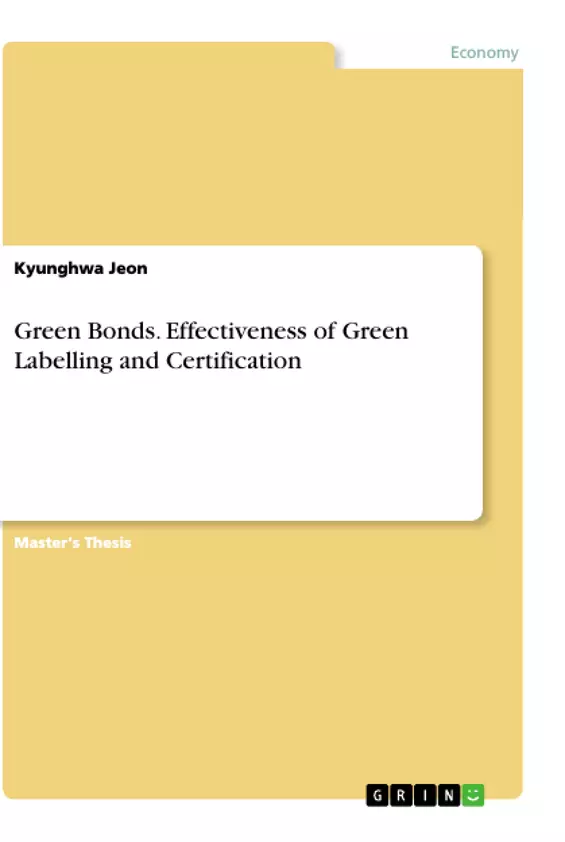This paper conducts the first comparative analysis of the financial performance of the certification and the green labelling for green bonds. Based on a unique dataset of 22 certified, 16 self-labelled and 7 unlabelled green bonds, the study contrasts the financial performance of the three green bond classes over the period 01/06/2016 to 13/07/2017. Over the full sample period, the labelled green bonds have significantly lower volatility than the unlabelled one, while there is no significant performance differences between the certified and self-labelled green bonds.
In terms of the relationship between the labelling and the price/yield changes, no significant evidence is detected throughout the given period. Consequently, this paper’s discovery concludes that the green labelling offers stakeholders the opportunity to reduce the volatility whereas the other effects on the price or yields are inconclusive.
Inhaltsverzeichnis (Table of Contents)
- Abstract
- Acknowledgement
- Table of Contents
- List of Acronyms
- List of Tables
- List of Figures
- Green Bonds: Effectiveness of Green Labelling & Certifications
- Introduction
- Purpose
- Research Questions and Hypothesis
- Limitations of Scope
- Outline of the Thesis
- Literature Review
- Green Bonds
- Green Bonds Market
- Green Bond Guidelines and Standards
- The Green Bond Principles (GBP)
- The Climate Bonds Standard (CBS)
- Challenges
- Lack of Supply of Green Bonds and Green Project
- Lack of Aggregation Mechanisms for Green Bonds
- Lack of Green Bonds Definition and Framework
- Lack of Information and Market Knowledge
- Lack of Clear Risk Profile of Green Investments
- Introduction to Bond Theory
- Term to Maturity
- Principal and Coupon
- Currency
- Yield
- Yield Spread
- Pricing of Bonds
- Yield to Maturity
- Duration and Modified Duration
- Previous Research
- Quantitative Bond Studies
- Greenwashing
- Comparative Analyses
- Data and Methodology
- Research Objectives
- Data Collection Method
- Data Description
- Data used to Test Volatility
- Data used to Test Price and Yield to Maturity
- Empirical Methods
- Methodology for Hypothesis One: Test Volatility
- Methodology for Hypothesis Two: Test Impacts of Being Higher Certification
- Empirical Results and Discussion
- Descriptive Statistics
- Hypothesis One: Test Volatility
- Hypothesis Two: Test Impacts of Being Higher Certification
- Test on Price
- Test on Yield
- Robustness of Results
- Discussion
- Hypothesis One: Test Volatility
- Hypothesis Two: Test Impacts of Being Higher Certification
- Conclusion
- Research Aims
- Empirical Results
- Future Research
- References
- Appendix
Zielsetzung und Themenschwerpunkte (Objectives and Key Themes)
This dissertation aims to conduct a comparative analysis of the financial performance of green bonds with different levels of green labelling and certification. The study analyzes a unique dataset of 22 certified, 16 self-labelled, and 7 unlabelled green bonds to examine their financial performance over a specific period.
- The effectiveness of green labelling and certification in enhancing the financial performance of green bonds.
- The impact of green labelling on the volatility, price, and yield of green bonds.
- The differences in financial performance between certified, self-labelled, and unlabelled green bonds.
- The role of green bond guidelines and standards, such as the Green Bond Principles (GBP) and the Climate Bonds Standard (CBS), in influencing the market.
- The challenges and opportunities associated with the development and growth of the green bond market.
Zusammenfassung der Kapitel (Chapter Summaries)
The dissertation begins with an introduction outlining the purpose, research questions, scope limitations, and structure of the study. Chapter 2 presents a comprehensive literature review, exploring the concept of green bonds, the green bond market, green bond guidelines and standards, challenges facing the market, and relevant bond theory.
Chapter 3 focuses on the data and methodology used in the analysis. It details the data collection method, data description, and the empirical methods employed to test the hypotheses. Chapter 4 presents the empirical results and discussion, including descriptive statistics, the findings related to volatility, price, and yield, and an analysis of the robustness of the results.
Schlüsselwörter (Keywords)
The study examines the effectiveness of green labelling and certification for green bonds, focusing on the financial performance of certified, self-labelled, and unlabelled green bonds. It explores the impact of labelling on volatility, price, and yield, as well as the role of green bond guidelines and standards in the market. Key terms include green bonds, green labelling, certified green bonds, self-labelled green bonds, unlabelled green bonds, climate bonds, green investment, and climate change.
- Arbeit zitieren
- Kyunghwa Jeon (Autor:in), 2017, Green Bonds. Effectiveness of Green Labelling and Certification, München, GRIN Verlag, https://www.grin.com/document/951509



